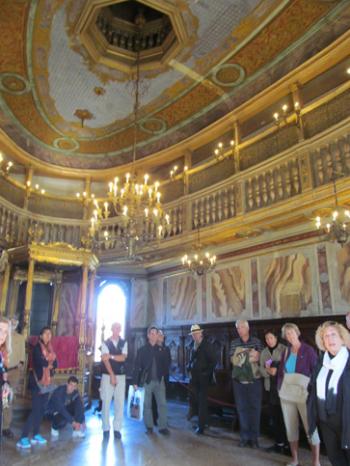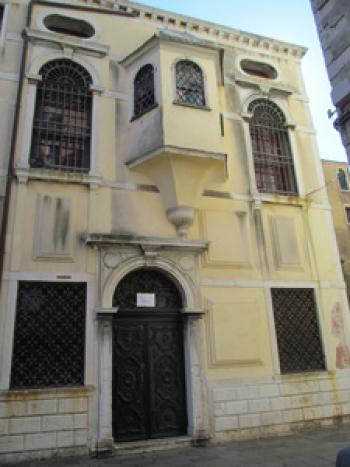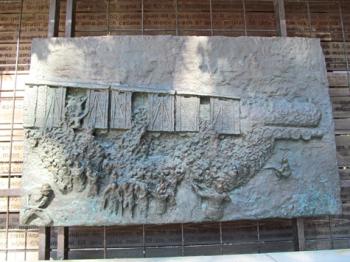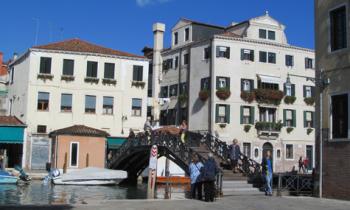Venice — world’s first Ghetto
This item appears on page 53 of the August 2017 issue.
2016 marked the 500th anniversary of the founding of the Ghetto in Venice, the first ghetto in the world. In March 1516, Venetian Doge Leonardo Loredan decreed that “Jews must all live together… in the Ghetto of San Girolamo…” which is in Cannaregio, one of the six sestieri, or sections, into which Venice is divided.
The Ghetto was then an abandoned foundry area where metal had once been cast. In the Venetian dialect, ghètar means “to cast” (in metal). This is believed to be the origin of the word gheto, or “foundry area,” over succeeding centuries destined to become layered with other meanings.
History of the Venetian Jews
Jews had been “allowed” to settle in Venice for centuries before the ducal decree was issued, possibly as early as the mid-12th century, according to a census taken in Venice in 1152 (perhaps even earlier). But from 1516 until July 1797, when the decree was revoked by Napoleon, Venice’s Jews were confined to a small area of approximately 1.25 acres, with some slight expansion in 1541 and 1633.
Into this area crowded not only Venetian Jews and those from other parts of Italy but also Jews expelled from England, France, Spain and Portugal as well as those from Germany, the Middle East and North Africa.
With so little land, they were forced to build up rather than out, constructing buildings often reaching seven or eight stories high or higher, with low ceilings. These were the residential skyscrapers of the 16th- and 17th-century Ghetto. There were limited entryways into the enclave that were closed off by law from dusk to dawn.
Jews were segregated in Venice for 281 years, which is why the 500th anniversary was in no way a celebration but, rather, a remembrance/commemoration of what once was.
In the mid-17th century, it is estimated that as many as 5,000 Jews lived in the Ghetto. Today there may be fewer than 500 in all of Venice, with few still living in the Ghetto.
Heart of the Ghetto
There is much to see in this small area, beginning with the iconic Campo del Ghetto Nuovo, which, despite its name, is the oldest part of the Ghetto and is regarded as its heart.
The subject of numerous paintings, photographs and postcards, the Campo is a large open space enclosed by tall buildings. Three ancient wellheads that once supplied water to the inhabitants dot the open space. As in other parts of Venice, there is an atmospheric sotoportego, a passage that cuts through a building to connect one street with another.
Opposite the side of the campo with the sotoportego is a wall with seven bronze plaques (1980) by the Lithuanian-Jewish artist Arbit Blatas. They depict Venetian Jews being deported to concentration camps during World War II. Few returned. Symbolic barbed wire is strung atop the wall above the plaques. On an adjacent wall is Blatas’ “Last Train” (1980), with the names and ages of 246 Venetian Jews who were deported.
Close to the sotoportego, at Cannaregio 2902/b, is the excellent small Museo Ebraico di Venezia (Jewish Museum of Venice), displaying manuscripts, embroidered vestments and ritual silver objects. Especially interesting are the ketubahs, prenuptial contracts.
Synagogue tours
It is in the museum that visitors can sign up for a guided tour of three of the Ghetto’s still-existing five synagogues, each of which is called a scola (the Venetian-dialect word for the Italian word “scuola,” or school. The oldest of them, Scola Tedesca (German School), located above the museum, was founded in 1529. It is a relatively small space, as are most of the Ghetto synagogues, and it is elegant, with wood-paneled benches on the first level and an oval women’s gallery above.
There is a bimah, the raised platform from which the Torah is read, and an aron, the cupboard that holds the Torah scrolls. Each of the synagogues has a bimah and an aron.
Adjacent to Scola Tedesca is Scola Canton, founded in 1531 probably as a private synagogue for a few wealthy families. Noteworthy is the impressive bimah and the medallions with paintings depicting biblical scenes, including the parting of the Red Sea and the Ark of the Covenant.
Nearby is Scola Italiana, built in 1575 but with a mid-18th-century interior. The bimah and the aron dominate the wood-paneled space.
Two other synagogues that were not offered on the tour we took are located steps away in the Ghetto Vecchio (Old Ghetto). Despite its name, the Ghetto Vecchio is newer than the Ghetto Nuovo by about 25 years.
Here are found Scola Levantina, founded in 1541, and Scola Spagnola, from about 1585. Both may have been redesigned in the 17th century by Baldassare Longhena, one of Venice’s most famous Baroque-era architects. Longhena designed Venice’s magnificent Basilica di Santa Maria della Salute on the Grand Canal.
What else to see
Though the Ghetto is small, there are plenty of shops, restaurants and cafés. One of the best shops, a bookstore, is located inside the Jewish Museum. Also inside the museum is a small café serving coffee and excellent pastries. There are also shops in the Campo del Ghetto Nuovo that sell Judaica as well as Venetian souvenirs. Prices for Murano glass rings, bracelets and pendants cost considerably less there than in the other more touristy areas of the city.
I recommend lunch at the restaurant Ghimel Garden (phone+39 041 243 0711, www.ghimelgarden.com), particularly sitting outside on the terrace beside the canal. Located in a corner of the Campo del Ghetto Nuovo at Cannaregio 2873/c, Ghimel Garden serves Jewish specialties like latkes (potato pancakes) and falafel as well as pastas, fish and pizza. They offer no meat dishes, however.
If you go…
The Jewish Museum (phone 39 041 715359, www.museoebraico.it/English) is open daily (except Saturdays and on Jewish holidays) from 10 to 7, June to September, and from 10 to 5:30, October to May. Admission to the museum costs €4, about $4.40 at the time my husband and I visited in October 2016.
Synagogue tours in English and Italian are given in summer, starting on the half hour between 10:30 and 5:30 from Sunday to Friday. In winter, tours take place 10:30 to 4:30. The tour cost is €10 and includes entry to the museum.
The Ghetto is located in Cannaregio about half a mile from the Santa Lucia train station. The closest vaporetto (water bus) stops are Ponte Guglie, from which it is a 10-minute walk to the Campo del Ghetto Nuovo, and Santa Marcuola, about a 15-minute walk.




